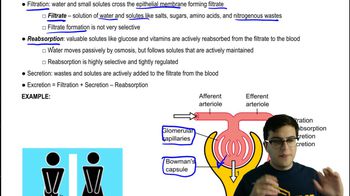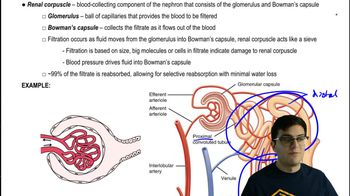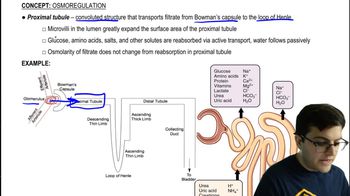Table of contents
- 1. Introduction to Biology2h 40m
- 2. Chemistry3h 40m
- 3. Water1h 26m
- 4. Biomolecules2h 23m
- 5. Cell Components2h 26m
- 6. The Membrane2h 31m
- 7. Energy and Metabolism2h 0m
- 8. Respiration2h 40m
- 9. Photosynthesis2h 49m
- 10. Cell Signaling59m
- 11. Cell Division2h 47m
- 12. Meiosis2h 0m
- 13. Mendelian Genetics4h 41m
- Introduction to Mendel's Experiments7m
- Genotype vs. Phenotype17m
- Punnett Squares13m
- Mendel's Experiments26m
- Mendel's Laws18m
- Monohybrid Crosses16m
- Test Crosses14m
- Dihybrid Crosses20m
- Punnett Square Probability26m
- Incomplete Dominance vs. Codominance20m
- Epistasis7m
- Non-Mendelian Genetics12m
- Pedigrees6m
- Autosomal Inheritance21m
- Sex-Linked Inheritance43m
- X-Inactivation9m
- 14. DNA Synthesis2h 27m
- 15. Gene Expression3h 20m
- 16. Regulation of Expression3h 31m
- Introduction to Regulation of Gene Expression13m
- Prokaryotic Gene Regulation via Operons27m
- The Lac Operon21m
- Glucose's Impact on Lac Operon25m
- The Trp Operon20m
- Review of the Lac Operon & Trp Operon11m
- Introduction to Eukaryotic Gene Regulation9m
- Eukaryotic Chromatin Modifications16m
- Eukaryotic Transcriptional Control22m
- Eukaryotic Post-Transcriptional Regulation28m
- Eukaryotic Post-Translational Regulation13m
- 17. Viruses37m
- 18. Biotechnology2h 58m
- 19. Genomics17m
- 20. Development1h 5m
- 21. Evolution3h 1m
- 22. Evolution of Populations3h 52m
- 23. Speciation1h 37m
- 24. History of Life on Earth2h 6m
- 25. Phylogeny2h 31m
- 26. Prokaryotes4h 59m
- 27. Protists1h 12m
- 28. Plants1h 22m
- 29. Fungi36m
- 30. Overview of Animals34m
- 31. Invertebrates1h 2m
- 32. Vertebrates50m
- 33. Plant Anatomy1h 3m
- 34. Vascular Plant Transport2m
- 35. Soil37m
- 36. Plant Reproduction47m
- 37. Plant Sensation and Response1h 9m
- 38. Animal Form and Function1h 19m
- 39. Digestive System10m
- 40. Circulatory System1h 57m
- 41. Immune System1h 12m
- 42. Osmoregulation and Excretion50m
- 43. Endocrine System4m
- 44. Animal Reproduction2m
- 45. Nervous System55m
- 46. Sensory Systems46m
- 47. Muscle Systems23m
- 48. Ecology3h 11m
- Introduction to Ecology20m
- Biogeography14m
- Earth's Climate Patterns50m
- Introduction to Terrestrial Biomes10m
- Terrestrial Biomes: Near Equator13m
- Terrestrial Biomes: Temperate Regions10m
- Terrestrial Biomes: Northern Regions15m
- Introduction to Aquatic Biomes27m
- Freshwater Aquatic Biomes14m
- Marine Aquatic Biomes13m
- 49. Animal Behavior28m
- 50. Population Ecology3h 41m
- Introduction to Population Ecology28m
- Population Sampling Methods23m
- Life History12m
- Population Demography17m
- Factors Limiting Population Growth14m
- Introduction to Population Growth Models22m
- Linear Population Growth6m
- Exponential Population Growth29m
- Logistic Population Growth32m
- r/K Selection10m
- The Human Population22m
- 51. Community Ecology2h 46m
- Introduction to Community Ecology2m
- Introduction to Community Interactions9m
- Community Interactions: Competition (-/-)38m
- Community Interactions: Exploitation (+/-)23m
- Community Interactions: Mutualism (+/+) & Commensalism (+/0)9m
- Community Structure35m
- Community Dynamics26m
- Geographic Impact on Communities21m
- 52. Ecosystems2h 36m
- 53. Conservation Biology24m
42. Osmoregulation and Excretion
Osmoregulation and Excretion
Problem 1a
Textbook Question
Textbook QuestionUnlike an earthworm's metanephridia, a mammalian nephron a. is intimately associated with a capillary network. b. functions in both osmoregulation and excretion. c. receives filtrate from blood instead of coelomic fluid. d. has a transport epithelium.
 Verified step by step guidance
Verified step by step guidance1
Step 1: Understand the question. The question is asking for the difference between an earthworm's metanephridia and a mammalian nephron.
Step 2: Recall what you know about earthworm's metanephridia and mammalian nephrons. Metanephridia are excretory organs in earthworms that filter waste from the coelomic fluid. Mammalian nephrons, on the other hand, are part of the kidney and filter waste from the blood.
Step 3: Evaluate each option. Option a is true, mammalian nephrons are associated with a capillary network. Option b is also true, mammalian nephrons function in both osmoregulation and excretion. Option d is true as well, mammalian nephrons have a transport epithelium.
Step 4: The correct answer is option c. Unlike an earthworm's metanephridia, a mammalian nephron receives filtrate from blood instead of coelomic fluid. This is the key difference between the two.
Step 5: Review the answer. The mammalian nephron, unlike the earthworm's metanephridia, is associated with a capillary network, functions in both osmoregulation and excretion, has a transport epithelium, and receives filtrate from blood instead of coelomic fluid.
Recommended similar problem, with video answer:
 Verified Solution
Verified SolutionThis video solution was recommended by our tutors as helpful for the problem above
Video duration:
26sPlay a video:
Was this helpful?
Key Concepts
Here are the essential concepts you must grasp in order to answer the question correctly.
Nephron Structure and Function
The nephron is the functional unit of the kidney in mammals, responsible for filtering blood and forming urine. It consists of a renal corpuscle and a renal tubule, which work together to remove waste products and regulate water and electrolyte balance. Understanding the nephron's structure is crucial for distinguishing its functions from those of other excretory systems, such as the metanephridia in earthworms.
Recommended video:
Guided course

Functional Groups
Osmoregulation
Osmoregulation is the process by which organisms maintain the balance of water and solutes in their bodies. In mammals, the nephron plays a key role in osmoregulation by adjusting the concentration of urine based on the body's hydration status. This process is vital for homeostasis, ensuring that cells function optimally despite varying external conditions.
Recommended video:
Guided course

Osmoregulation and Nitrogenous Waste
Filtration Mechanism
The filtration mechanism in the nephron involves the glomerulus, a network of capillaries where blood is filtered to form filtrate. Unlike metanephridia, which filter coelomic fluid, mammalian nephrons filter blood directly, allowing for the selective removal of waste while retaining essential substances. This distinction is fundamental to understanding how different organisms adapt their excretory systems to their environments.
Recommended video:
Guided course

Filtration, Reabsorption, and Excretion

 7:16m
7:16mWatch next
Master Osmoregulation and Nitrogenous Waste with a bite sized video explanation from Jason Amores Sumpter
Start learningRelated Videos
Related Practice

































































